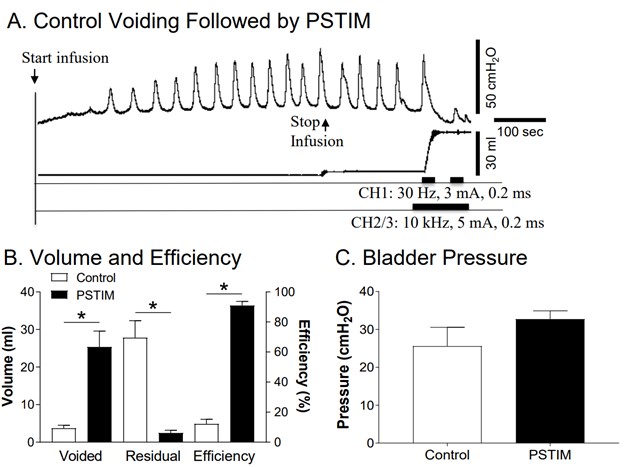Back
Poster, Podium & Video Sessions
Podium
PD24: Urodynamics/Lower Urinary Tract Dysfunction/Female Pelvic Medicine: Neurogenic Voiding Dysfunction
PD24-02: Neurogenic Bladder Management in Awake Chronic Spinal Cord Injured Cats by an Implantable Pudendal Nerve Stimulator
Saturday, May 14, 2022
9:40 AM – 9:50 AM
Location: Room 245
Jialiang Chen, Guangzhou, China, People's Republic of, Yihua Zhong, Beijing, China, People's Republic of, Jun Zhao, Xian, China, People's Republic of, Anand Mohapatra*, Bing Shen, Jicheng Wang, William de Groat, Changfeng Tai, Pittsburgh, PA
- AM
Podium Presenter(s)
Introduction: Spinal cord injury (SCI) can cause intricate medical conditions, including detrusor overactivity and detrusor sphincter dyssynergia. The most commonly used treatment, intermittent self-catheterization, can predispose patients to urinary tract infections. This study reveals a novel implantable pudendal nerve stimulation (PSTIM) to restore continence and micturition functions in the setting of neurogenic bladder from SCI.
Methods: The T9-T10 level of spinal cord was transected entirely in two cats to establish a model for SCI. PSTIM was surgically implanted in the cats with three cuff electrodes surrounding bilateral pudendal nerves (two on left, one on right). The cat’s bladder was emptied by Credé's maneuver or stimulation of PSTIM. Urodynamics was performed via urethral catheter to test the PSTIM functions in the awake cats. Finally, the cats were anesthetized with alpha-chloralose for terminal experiments. Bilateral ureters were externalized, and a urodynamic catheter was inserted through the bladder dome. Urodynamics was performed to evaluate voiding with control conditions and with PSTIM in the anesthetized cats.
Results: Stimulation of channel 1 at 30 Hz induced low bladder pressure (about 60 cmH20) under isovolumetric conditions by triggering spinal reflex bladder contraction. It also induced highly efficient micturition (both >95%) when combined with 10 kHz stimulation of bilateral pudendal nerves to relax the external urethral sphincter (channels 2 and 3). Additionally, stimulation of channel 1 at 5 Hz suppressed non-voiding contractions and significantly increased bladder capacity. In the anesthetized cats, control urodynamics demonstrated frequent low-pressure contractions ( < 50 cmH20) with low-efficiency voiding whereas PSTIM urodynamics demonstrated a low-pressure contraction with high-efficiency voiding (91% vs. 12% emptied, p<0.05). (Figure)
Conclusions: PSTIM to stimulate and/or block the pudendal nerve can restore continence and micturition functions after SCI. This novel neuroprosthesis can be a potential therapy for SCI patients to replace daily self-catheterization.
Source of Funding: This study is funded by the Department of Defense under contract W81XWH-15-C-0066.

Methods: The T9-T10 level of spinal cord was transected entirely in two cats to establish a model for SCI. PSTIM was surgically implanted in the cats with three cuff electrodes surrounding bilateral pudendal nerves (two on left, one on right). The cat’s bladder was emptied by Credé's maneuver or stimulation of PSTIM. Urodynamics was performed via urethral catheter to test the PSTIM functions in the awake cats. Finally, the cats were anesthetized with alpha-chloralose for terminal experiments. Bilateral ureters were externalized, and a urodynamic catheter was inserted through the bladder dome. Urodynamics was performed to evaluate voiding with control conditions and with PSTIM in the anesthetized cats.
Results: Stimulation of channel 1 at 30 Hz induced low bladder pressure (about 60 cmH20) under isovolumetric conditions by triggering spinal reflex bladder contraction. It also induced highly efficient micturition (both >95%) when combined with 10 kHz stimulation of bilateral pudendal nerves to relax the external urethral sphincter (channels 2 and 3). Additionally, stimulation of channel 1 at 5 Hz suppressed non-voiding contractions and significantly increased bladder capacity. In the anesthetized cats, control urodynamics demonstrated frequent low-pressure contractions ( < 50 cmH20) with low-efficiency voiding whereas PSTIM urodynamics demonstrated a low-pressure contraction with high-efficiency voiding (91% vs. 12% emptied, p<0.05). (Figure)
Conclusions: PSTIM to stimulate and/or block the pudendal nerve can restore continence and micturition functions after SCI. This novel neuroprosthesis can be a potential therapy for SCI patients to replace daily self-catheterization.
Source of Funding: This study is funded by the Department of Defense under contract W81XWH-15-C-0066.


.jpg)
.jpg)